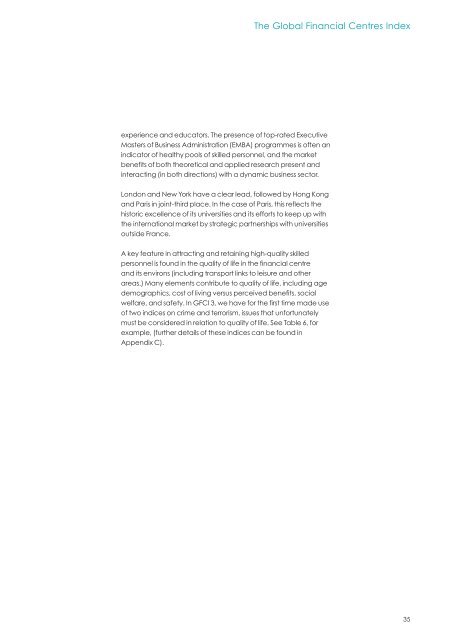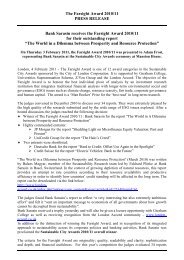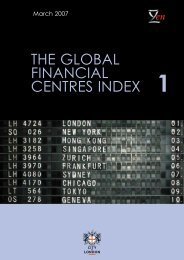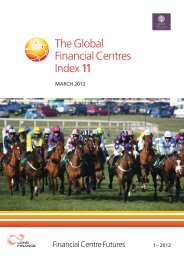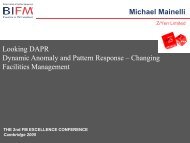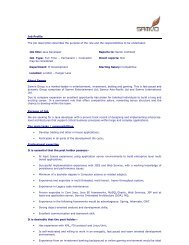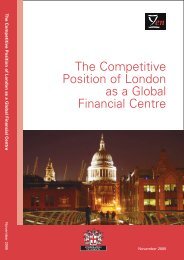The global financial centres index (GFCI) 3 - Z/Yen
The global financial centres index (GFCI) 3 - Z/Yen
The global financial centres index (GFCI) 3 - Z/Yen
Create successful ePaper yourself
Turn your PDF publications into a flip-book with our unique Google optimized e-Paper software.
<strong>The</strong> Global Financial Centres Index<br />
Global Property Index, IPD (November 2007) 1<br />
– <strong>The</strong> IPD <strong>global</strong> property <strong>index</strong> is intended to<br />
measure the combined performance of real<br />
estate investments held in mature investment<br />
markets worldwide. This <strong>index</strong> represents IPD’s<br />
first attempt to create a composite <strong>global</strong> <strong>index</strong><br />
that will be properly rebalanced to accurately<br />
reflect national market sizes and that will report<br />
<strong>global</strong> real estate investment performance in<br />
all major investor currencies back to the start of<br />
this decade. <strong>The</strong> <strong>index</strong> is based on the IPD<br />
indices for Austria, Canada, Denmark, France,<br />
Germany, Ireland, Italy, Netherlands, Norway,<br />
Portugal, South Africa, Spain, Sweden,<br />
Switzerland and the UK.<br />
Source: www.ipd<strong>global</strong>.com<br />
Direct Real Estate Volumes, Jones Lang LaSalle<br />
(July 2007) – This measures the total value of<br />
commercial real estate traded in a market<br />
during a 12 month period (including Office,<br />
Retail, Industrial and Hotel investments).<br />
Residential, Development and Entity-level deals<br />
are excluded. Data come from more than<br />
150 offices worldwide as well as third-party<br />
data providers.<br />
Source: www.joneslanglasalle.co.uk<br />
Real Estate Transparency Index, Jones Lang<br />
LaSalle (July 2007) – <strong>The</strong> transparency of <strong>global</strong><br />
real estate markets is ranked according to<br />
responses to 27 questions on a questionnaire –<br />
with a score of one being ‘transparent’ and a<br />
score of five being ‘opaque’. Ranking is<br />
qualitative following <strong>global</strong> categorisation<br />
standards and is conducted by Jones Lang<br />
LaSalle research and capital markets<br />
professionals and partners.<br />
Source: www.joneslanglasalle.co.uk<br />
E-Readiness Ranking, EIU (August 2007) b – <strong>The</strong><br />
E-readiness score is published annually by the<br />
Economist Intelligence Unit. It ranks countries<br />
according to the state of their information and<br />
communications technology (ICT) and the<br />
ability of its businesses, governments and<br />
consumers to make use of it. <strong>The</strong> need for such<br />
an <strong>index</strong> arises from the reasoning that the<br />
more a country does on line the more efficient<br />
(and transparent) its economy will be. <strong>The</strong> <strong>index</strong><br />
evaluates the way a country influences its<br />
information and communications infrastructure<br />
through political, economic, technological and<br />
social means. It is composed of nearly<br />
100 criteria with different weightings that are<br />
grouped in six main categories: connectivity,<br />
business environment, social and cultural<br />
environment, legal environment, consumer and<br />
business adoption (in other words, the scale on<br />
which businesses and consumers use ICT), as<br />
well as government and policy vision (in other<br />
words, how committed the country’s<br />
government is). <strong>The</strong> latest survey includes 69<br />
different countries with scores from zero to ten,<br />
zero being the lowest and ten the highest score.<br />
Source: www.economist.com<br />
Instrumental Factors for General<br />
Competitiveness<br />
Economic Sentiment Indicator, European<br />
Commission (November 2007) 1 – An indicator<br />
of overall economic activity, based on<br />
15 individual components, split between five<br />
confidence indicators, which are weighted in<br />
order to calculate the final score. <strong>The</strong><br />
confidence indicators (and their weightings)<br />
are: industry (40%), services (30%), consumer<br />
(20%), retail trade (5%) and construction (5%).<br />
Source: http://ec.europa.eu<br />
Super Growth Companies, Grant Thornton<br />
(November 2007) 1 – A ranking of countries<br />
based on the proportion of Super Growth<br />
Companies (companies which have grown<br />
considerably more than the average measured<br />
against key indicators including turnover and<br />
employment) within the country. <strong>The</strong> <strong>index</strong><br />
forms part of the Grant Thornton International<br />
Business Owners Survey (IBOS), which<br />
surveys more than 7,000 business owners in<br />
30 different countries.<br />
Source: www.grantthorntonibos.com<br />
World Competitiveness Scoreboard, IMD (June<br />
2007) – An overall competitiveness ranking for<br />
the 61 countries and regional economies<br />
covered by the World Competitiveness<br />
Yearbook. <strong>The</strong> economies are ranked from the<br />
most to the least competitive and performance<br />
can be analysed on a time-series basis.<br />
Source: www.imd.ch<br />
72


